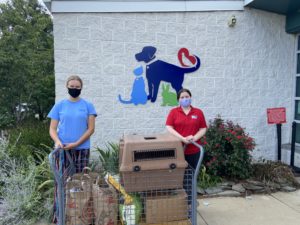When I was thinking about what I wanted to do for my Eagle project, I thought about possible career and future paths that I am interested in. Veterinary Medicine has been a significant interest of mine since I was young, and this interest inspired me to do a project that could help animals. So I decided to look into different shelters in my area and what they needed from me. That’s how I found the Animal Welfare League of Arlington (AWLA). I decided that I would help make blankets and snuffle mats (a type of ripped blanket that dogs like to play with), and collect any items they may need.
I decided to split my project into two sections: making blankets/snuffle mats and collecting other material donations. I began by recruiting Scouts from my Troop by emailing them to see if they were interested. Then I had them help make blankets and snuffle mats, and asked Troop families for donations such as cat and dog food, unused toys, litter, among other things. When COVID-19 became a reality, I had to put my plans to a halt temporarily. So I ha to adjust my plan to work online, and I brought supplies to each volunteer’s house before a Zoom session and picked up completed mats and blankets afterward. In each Zoom session, I used the EDGE (explain, demonstrate, guide, enable) method to demonstrate and teach volunteers how to make the mats and blankets. During this time, it was quite challenging to get supplies from stores and then get them to each individual’s home. Luckily, I had my driver’s license for my project. Still, the time it took to get enough supplies before each session, cut them into the correct sizes for each volunteer, and then drive to each person’s house to deliver and pick up was a tricky part of the project. My favorite aspect was seeing the Scouts over Zoom learning how to make the mats or blankets. A few of the girls in my Troop came to two sessions to learn how to make both mats and blankets, and some even asked for more materials after the first session so they could independently apply what they learned again! It was exciting for me to see their enthusiasm both for helping the animals through my project and continuing their skills outside of the learning sessions.
By completing this project, I learned the difficulty of organizing groups, primarily digitally, to work towards a common goal. I didn’t expect how hard it would be to get schedules coordinated, but by the third session, I realized how much easier it was for me to plan compared to the first. I grew as a leader; I learned more about using the EDGE method and applying it to real situations. I gained more experience in finding the flaws in teaching plans and adapting them over time.

